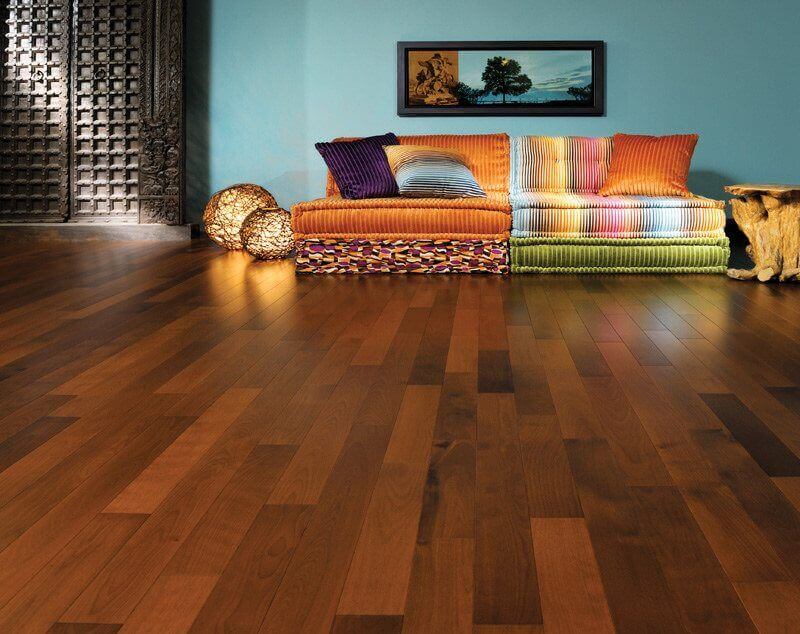Learn the Basics of Exotic Hardwood Flooring
November 11, 2014
In one of our September posts, we took a look at a few of the more popular domestic woods used for hardwood flooring. This month, we wanted to explore some of the exotic hardwood species that have become popular for flooring in recent years.
Though the word “exotic” may call to mind wild jungles and hard-to-reach rainforests, in fact, when we’re talking about wood, it just refers to any species grown outside of North America. Many of the species most familiar to you fall into this category, including mahogany, teak and rosewood. While many exotic species do originate in the tropics, there are a few that come from other places as well. We will get into the origins of specific species later, though.
Why do people choose exotic woods?

Appearance
Most exotic wood species have a color and grain that is very distinct, and much different from those found in domestic woods, which tend to be a bit more consistent and subtle. Many exotic hardwoods show a striking difference in color from heartwood to sapwood, from board to board, or, as with zebrawood and tigerwood , even from grain to grain. Consequently, a hardwood floor made from an exotic species tends to make a bolder statement and be more striking in home, though always with the characteristic warmth of wood.
Durability
Taken as a whole, exotic hardwoods tend to be denser and harder than domestic woods, testing higher on the Janka hardness scale in the majority of cases. This lends strength and durability to their inherent beauty, enabling simpler finishes that let that beauty shine through. They also tend to require less maintenance as a result, and their unique grain patterns often hide scuffs and scratches better than more uniform domestic species. Of course, modern advances in the industry tend to ensure that any hardwood, exotic or domestic, is likely to last a lifetime and longer.
What are the challenges of exotic hardwood?
Color changes
As you have probably learned by now, any wood species should be expected to change color over time, especially if exposed to the sun’s UV light. Many exotic wood species seem to have a higher tendency toward such changes, and the difference is often more dramatic than in most domestics. Before you choose a species, you should talk to one of the professionals here at MacDonald Hardwoods to be sure you know what to expect as your floors age.
Resistance to finishes
The density that lends exotic hardwoods their hardness can also make them resistant to added color or complex finishes. Fortunately, most people who opt for exotic hardwood do so for its natural coloring, and often opt for protective oil-based finishes rather than stains or polyurethanes. If you do choose to finish your exotic hardwood, do your research and make sure that your finish is known to take well on the specific species you’ve chosen.
Less stability
Remember, tropical woods are far from home in North America. They come largely from climates that are fairly consistent in temperature and high in humidity. They are not always well adapted, then, for the drastic changes in both temperature and humidity experienced throughout most of the U.S. For this reason, it is especially important that exotic hardwood flooring be installed by someone with experience in accommodating the higher expansion and contraction rates of these reactive woods. It may also be advisable to choose an engineered variety over a solid exotic hardwood, as an engineered plank will consist largely of more stable woods, with a layer of your beautiful exotic on top.
Availability
In general, the more popular exotic hardwoods are widely available as both engineered and solid flooring, but, especially if you are shopping for hardwoods online or in catalogs, it is best to visit a showroom before setting you heart on a specific wood. The availability of your favorite species can depend on the trends in your area as well as situations in the woods country of origin, including their ability to enforce sustainable harvesting practices. You may find that the species at the core of your decorative scheme is in short supply this year and only available in a few sizes or has to be shipped so far that the added cost becomes unreasonable. So, when thinking about exotics, try to stay flexible.
Are exotic hardwoods harvested with the health of the environment in mind?
You noticed we mentioned sustainable harvesting practices. All around the world, the lumber industry is working with governments, environmentalists, trade organizations to ensure that sustainable practices are put in place and maintained.
Recently, the Lacey Act, which has regulated lumber production practices in the United States for more than a century, was extended to include lumber harvested overseas. The Act expressly prohibits all trade in plant and plant products (furniture, paper, lumber, etc.) illegally here or abroad, including wood from trees that have been taken against the will of the landowner or without proper authorization or have been harvested from officially protected areas. Those bringing lumber into the country must provide proof of provenance, declaring the country of origin of harvest and species name of all plants contained in their products.

Of course, the degree to which areas are protected varies from country to country, but organizations like the Forest Stewardship Council are making it easier to ensure that exotic hardwoods are ethically harvested by following their path of production and giving lumber that passes muster their seal of approval.
You can read more about where wood flooring comes from in our earlier post on the subject, here.
Ready to take the exotic wood plunge?
Be sure to check back in the coming weeks for more on some specific species that are sure to make your heart flutter and, in the meantime, take a look at some of the exotic hardwoods in the MacDonald Hardwoods gallery.
Tigerwood image by Jim_K-Town via flickr, some rights reserved.






